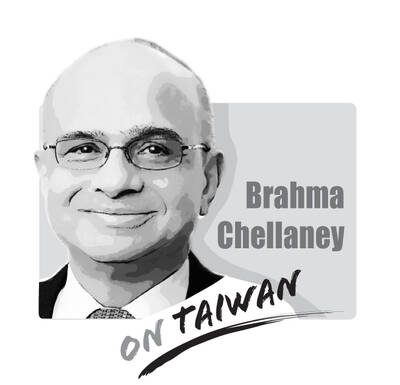New Taipei City Mayor Hou You-yi (侯友宜) caused a stir on Saturday when he said he would not head the city’s campaign office for Kaohsiung Mayor Han Kuo-yu’s (韓國瑜) presidential campaign.
Reading between the lines, Hou understands that the public detests the infighting between the pan-blue and pan-green camps and is pursuing a strategy aimed at dissolving the nation’s “color politics.” He thinks there is nothing wrong with sharing a stage with a pan-green politician if that could help boost the city’s budget and secure more infrastructure projects.
Hou was conspicuously absent from the Chinese Nationalist Party’s (KMT) National Congress in New Taipei City last month, at which Han was officially nominated as the party’s presidential candidate.
Hou was bombarded with criticism by Han’s supporters, who accused him of discourtesy and pulling up the drawbridge. He continues to forge his own path, firmly believing that voters will reward him for prioritizing the efficient management of New Taipei City beyond tribal blue-green politics.
Those familiar with the election process know that being the director of a campaign headquarters is a formality: The campaign secretary-general and heads of local party chapters do the heavy lifting. That Hou was not prepared to even keep up appearances left observers wondering where his political sympathies really lie.
Although Hou won as the KMT’s New Taipei City mayoral candidate, his style is markedly different from that of conventional KMT candidates. This might be due to his background as a police officer, which installed in him an innate sense of right and wrong, and the importance of seeking truth from facts.
Although Hou gets on well with both sides of the political spectrum, he dislikes being pigeonholed as “green,” “blue” or any other color politician.
During last year’s local elections, Hou was criticized by some in his party as “blue-skinned, but green to the bone.” He responded that he had never been a member of the Democratic Progressive Party (DPP), although he had been approached by the party to run for Taichung mayor or Chiayi County commissioner, but he turned down the offer.
Hou understands that most people are fed up with blue-green politics. During the election campaign, he frequently attacked the “chaos” of blue-green politics and refused to accept even a cent in political subsidies.
When standing on a platform with KMT Chairman Wu Den-yih (吳敦義) and other prominent members of the party, he kept the interaction as brief as possible.
Before the elections, when he was at photo ops with then-Kaohsiung and Taichung mayoral candidates Han and Lu Shiow-yen (盧秀燕), it was simply a matter of campaign strategy.
Hou won the New Taipei City mayoralty by 300,000 votes with only limited KMT assistance. Instead, he relied on his “strong-man” persona and capitalized on an anti-DPP mood, while positioning himself as neither blue nor green to attract swing voters.
Hou understands that people want a good job and a quiet life, and that they abhor venomous political attacks and mudslinging. His strategy has been to focus on running his municipal administration and to keep a relatively low-key online profile, while quietly delivering “frontline services.”
His accomplishments are borne out by polling data: His administration enjoys an approval rating of 75 percent. This should encourage Hou to continue to chart his own course.
Lai Hsiao-tung writes for the Liberty Times.
Translated by Edward Jones

Taiwan stands at the epicenter of a seismic shift that will determine the Indo-Pacific’s future security architecture. Whether deterrence prevails or collapses will reverberate far beyond the Taiwan Strait, fundamentally reshaping global power dynamics. The stakes could not be higher. Today, Taipei confronts an unprecedented convergence of threats from an increasingly muscular China that has intensified its multidimensional pressure campaign. Beijing’s strategy is comprehensive: military intimidation, diplomatic isolation, economic coercion, and sophisticated influence operations designed to fracture Taiwan’s democratic society from within. This challenge is magnified by Taiwan’s internal political divisions, which extend to fundamental questions about the island’s identity and future
Taiwan People’s Party (TPP) Chairman Huang Kuo-chang (黃國昌) is expected to be summoned by the Taipei City Police Department after a rally in Taipei on Saturday last week resulted in injuries to eight police officers. The Ministry of the Interior on Sunday said that police had collected evidence of obstruction of public officials and coercion by an estimated 1,000 “disorderly” demonstrators. The rally — led by Huang to mark one year since a raid by Taipei prosecutors on then-TPP chairman and former Taipei mayor Ko Wen-je (柯文哲) — might have contravened the Assembly and Parade Act (集會遊行法), as the organizers had
Minister of Foreign Affairs Lin Chia-lung (林佳龍) last week made a rare visit to the Philippines, which not only deepened bilateral economic ties, but also signaled a diplomatic breakthrough in the face of growing tensions with China. Lin’s trip marks the second-known visit by a Taiwanese foreign minister since Manila and Beijing established diplomatic ties in 1975; then-minister Chang Hsiao-yen (章孝嚴) took a “vacation” in the Philippines in 1997. As Taiwan is one of the Philippines’ top 10 economic partners, Lin visited Manila and other cities to promote the Taiwan-Philippines Economic Corridor, with an eye to connecting it with the Luzon
The Chinese Nationalist Party (KMT) has postponed its chairperson candidate registration for two weeks, and so far, nine people have announced their intention to run for chairperson, the most on record, with more expected to announce their campaign in the final days. On the evening of Aug. 23, shortly after seven KMT lawmakers survived recall votes, KMT Chairman Eric Chu (朱立倫) announced he would step down and urged Taichung Mayor Lu Shiow-yen (盧秀燕) to step in and lead the party back to power. Lu immediately ruled herself out the following day, leaving the subject in question. In the days that followed, several